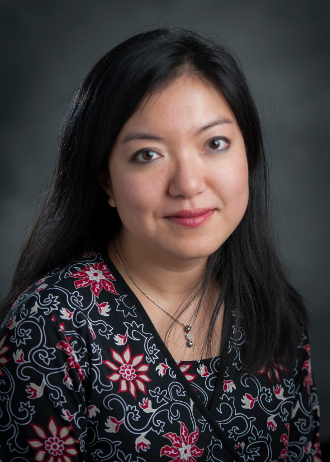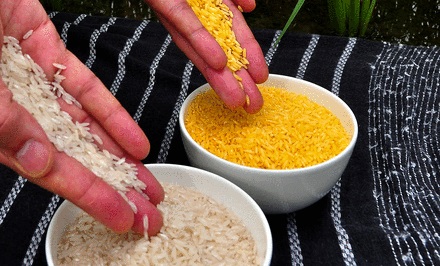Opinion: MSU food safety expert Felicia Wu encourages rice-eating countries with vitamin A deficiency to consider Golden Rice
In December 2021, Wu co-authored an opinion piece detailing the dire consequences of vitamin A deficiency for children in many developing countries and the need to address the problem head on.

Genetically modified organisms (GMOs) have been a popular target of science skeptics for years, labeled as “Frankenfoods” and unhealthy, laboratory concoctions made by greedy corporations.
For Felicia Wu, John A. Hannah Distinguished Professor of food safety, toxicology and risk assessment at Michigan State University, concern about the effects of this misinformation is mounting. Wu, whose work is also supported by MSU AgBioResearch, is an expert on foodborne disease and food safety.
She studies the effects of foodborne toxins and examines economically viable ways to improve food safety and nutrition in the U.S. and worldwide. Wu has been involved with World Health Organization (WHO) and United Nations Food and Agriculture Organization panels on estimating the global burden of disease, conducting risk assessments of food additives and contaminants, and evaluating the impact of animal-source foods on global nutrition.
For her work in food safety risk assessment and management, Wu has been elected a Fellow of the Society for Risk Analysis. Her research has been funded by the U.S. Department of Agriculture, the National Institutes of Health, the Bill & Melinda Gates Foundation and the U.S. Agency for International Development, among others.
In December 2021, Wu co-authored an opinion piece published in the Proceedings of the National Academy of Sciences (PNAS), one of the world’s leading scientific journals. The group details the dire consequences of vitamin A deficiency for children in many developing countries and the need to address the problem head on.
According to the WHO, vitamin A deficiency is a public health problem in more than half of all countries, particularly those in Africa and Southeast Asia. Vitamin A is essential for growth and development, immune system function, vision and hearing.
The most vulnerable populations to vitamin A deficiency complications are children and pregnant women. The WHO estimates that 250,000 to 500,000 vitamin A-deficient children become blind every year, and half die within 12 months of losing their sight.
But there is hope. While white rice and cereal grains are readily available to many, they lack sufficient nutrients to form the foundation of a diet. Developed in the 1990s, Golden Rice was later modified in 2004, and it contains transgenes from maize and a common soil bacterium. Put simply, Golden Rice produces beta-carotene, a precursor to vitamin A proven to be an effective source of vitamin A for humans.
Fears around transgenic and GMO foods, however, have stalled the production and availability of Golden Rice. Wu and her colleagues are moving to change that.

Q&A with Felicia Wu
As a scientist, how do you feel about current public trust in science and research?
I think that public trust in science and research has never been as high as scientists would like, and that has been the unfortunate case since at least hundreds of years ago in Galileo’s time. Media, including social media, could be used to promote scientific findings, but of course they are also used to spread ideas that are not scientifically based.
But – and here my scientific colleagues and friends might disagree with me – I’m cautiously optimistic about humankind’s relationship to science. Key differences between Galileo’s time and ours are that many more books have been published, a much larger proportion of the global population is able to read, a much larger proportion of the population has at least an elementary school education, and scientific fields, as well as the philosophy of science, have evolved so much. As a result, on the whole, we live with far less superstition and fear than we had in past centuries. We’re given at least the basis of how to think about issues with reason and logic.
In your view, why has the topic of GMOs been so controversial? Where does the misinformation come from and what’s the motivation behind it?
Many new food technologies have been controversial. Interestingly, hybrid crops, first developed in the late 1800s and then much more widespread by the mid-1900s, were also viewed with deep skepticism, distrust, and comments of “playing God” when first introduced in agriculture. I think that food is something that feels very elemental to all of us. Yet it’s such an interesting paradox, how we think of food. On the one hand, you could say that we love to eat junk food and should be much more careful about what we eat. On the other hand, when you tell people that some of their food is genetically modified, they can get up in arms and oppose it. I think, in part, it’s that they do not know or do not understand what genetic modification of food means, and the specifics of the modifications. And that is something we as scientists need to work to communicate better.
Do you see any improvements in the willingness of policymakers to engage in science-based conversations on GMOs?
I think policymakers in the U.S. have generally been willing to engage in science-based conversations on GMOs from the start, when we first approved them in the 1980s (Ice-Minus) and 1990s (GM crops). In other parts of the world, it is very different. There are many reasons discussions of GMOs have been hung up at governmental levels, including complex regulatory agencies or no regulatory agencies that would oversee GMO assessment, food safety concerns, fears of trade barriers such as with the European Union, and the use of the Precautionary Principle on new technologies – that if there is any chance that a new biotechnology could cause risk, then that is sufficient reason to ban it.
What makes Golden Rice a viable tool in combating vitamin A deficiency? What other things can be done to help solve this problem and other nutrition-related challenges?
Golden Rice is especially well-suited to deliver beta-carotene, the precursor to vitamin A, to certain global populations. First, the technology is free. Golden Rice traits can be introduced into any rice variety at no extra cost, per the Golden Rice Humanitarian Board’s efforts (started by the scientists who created it). So it is no more expensive than regular rice. Second, rice is a staple food in many diets around the world. Third, the beta-carotene in Golden Rice is easily absorbed, and the conversion of beta-carotene to vitamin A has been shown to be very high. Fourth, it is often not easy or efficient for farmers to grow crops that contain beta-carotene, such as leafy green vegetables like spinach or orange-colored produce such as mangoes or carrots, in many parts of the world where rice is grown.
We like to say, “You should increase your dietary diversity,” but the reality in many resource-poor populations worldwide is that this is nearly impossible because of economic, agronomic and other constraints. Of course, we should move toward improving dietary access and diversity worldwide. But we should not let the perfect be the enemy of the good. We can continue to work on this issue while introducing biofortified foods to meet people’s nutritional needs. And we have a precedence of doing this, such as introducing folic acid to cereals and flour products and adding iodine to salt. These all help to prevent human diseases of malnutrition.
Why did you and your colleagues choose to write this opinion piece now?
Although Golden Rice has been available in its current form since 2004, and although multiple governments worldwide had already approved its safety for human consumption, no government had approved its cultivation at the time we started writing our piece. Meanwhile, hundreds of thousands of children worldwide have been dying every year from diseases related to vitamin A deficiency. We have already been planting GMOs around the world for over 25 years, and some of the countries that are still deciding on Golden Rice have already approved other GMOs. It seems a shame that a crop that could deliver real nutritional benefits that could improve the health of children worldwide has been hung up because of anti-GMO forces that have lobbied worldwide to prevent Golden Rice’s approval. Interestingly, while we were in the middle of writing this piece, the government in the Philippines did approve Golden Rice in July 2021. So it’s possible that the tide is turning now.



 Print
Print Email
Email




